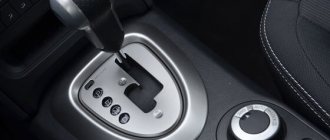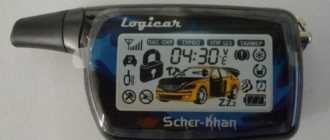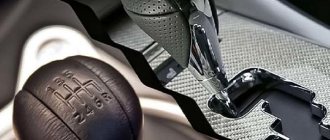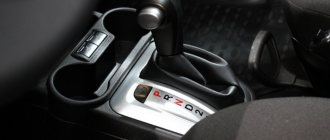02/26/2022 5,805 Transmission
Author: Victor
An automatic transmission is a good option for novice drivers who are just learning to drive a car. When driving a car with an automatic transmission, the driver does not need to monitor the gear shift when driving in different modes. We suggest that you familiarize yourself in detail with the instructions for the automatic transmission and find out what you cannot do when using an automatic transmission.
[Hide]
Operating modes of automatic transmissions
In order to use the automatic transmission correctly, we first suggest understanding the purpose of the main operating modes of the unit.
Main functions
What features do all automatic transmissions have:
- P mode or parking. When this position is activated, the transmission locks the vehicle's chassis, regardless of whether the drive is installed on it - front or rear. As a result, the vehicle will not move; all gears are disabled when mode P is activated. This position cannot be engaged if the car is still moving and has not completely stopped.
- R mode. This function is designed to allow the vehicle to move in reverse. Its activation is allowed after the vehicle has come to a complete stop.
- Neutral gear N. If there are malfunctions in the automatic transmission or power unit, when you cannot start the engine, mode N will allow you to move the car forward and backward over short distances. Unlike manual transmissions, the neutral mode on an automatic transmission has certain operating features. It is not allowed to be turned on in traffic jams; its activation is possible in emergency situations.
- Mode D or Drive. Designed to ensure forward movement of the machine. In automatic transmissions, this mode is blocked from accidental activation. If it is necessary to switch from the Drive function, this can only be done if the driver presses the brake pedal.
- Function "4-3-2-L". Belongs to the category of special modes used to operate the vehicle in different conditions. In each of these positions a certain number of speeds can be used. For example, in mode 3 there are three gears, and in position L there is only one speed. Thanks to this function, the automatic transmission does not overheat the power unit. The first three functions are best used when driving uphill.
From the video of the Open Studio Kostroma channel you can learn about operating a car with an automatic transmission.
Tiptronic mode
One of the features of modern automatic transmissions is the presence of the Tiptronic function. This type of gearbox refers to automatic transmissions that support manual transmission control mode. Thanks to its presence, the driver can control the process of movement in difficult conditions. If you are tired of driving an automatic transmission, you can switch to manual control. At the checkpoint inside the car, in addition to the traditional modes, you will see a special recess with the symbols “+” and “-”. “+” is an increase in gear, from first and higher, and “-” is a downshift.
Sports modes
The transmissions of some car models have a sport mode function - Sport or Kickdown. Activating this position allows you to increase the speed of the power unit and artificially switch to a lower gear. If necessary, sport modes allow you to achieve sharp acceleration, for example, when you need to overtake on the highway. When this position is turned on, maximum motor power is used, but this function is generally uneconomical for constant use.
Other modes
Depending on the car manufacturer, the automatic transmission may have other operating modes:
- D3 or S - reduced speed. A good option for operating a vehicle when driving uphill. By activating this position, the driver can brake and control the vehicle more effectively.
- D2. This is usually the same as position L or 2. It is also a reduced speed function for driving downhill or uphill. Its use is relevant when moving on sand, ice or when driving in difficult conditions.
- Economical - E. Its activation allows you to use engine power economically to reduce fuel consumption.
- Winter mode. He can o, "W", "HOLD", "Winter". When this position is activated, a gentle driving mode is activated on snowy terrain, for example, when driving on ice or mud. In most vehicles, this position has limitations in regular use due to the increased load on the mechanisms and transmission units. Due to overheating, its use is not allowed in the warm season when driving on dry asphalt.
Practical lessons
Set the selector to the required mode by following these steps:
- Start the engine (you can only switch the lever when the engine is running).
- Depress the brake pedal.
- Press the desired mode button located on the selector (if necessary).
- Select a position that corresponds to the desired direction of movement of the machine: “D” - the vehicle will go forward, “N” - neutral, the machine will stand still or roll downhill, “R” - it will go backward. When the driver selects the gear, the car will not start moving, but when you release the brake pedal, the car will move. Take this nuance into account; do not remove your foot from the “brake” ahead of time to avoid an accident.
Automatic transmissions recognize the driver's commands by pressing the gas pedal: smooth acceleration, gradual gear shifting is ensured by pressing with little force. Intense acceleration, required when overtaking, is achieved by pressing the gas pedal to the floor, while the automatic transmission will first shift into a lower gear, then the car will begin to accelerate. Please note: from the moment you press the gas pedal until the vehicle accelerates, there is a slight delay, about one second; this time is imperceptible when driving slowly, and can be fatal in overtaking conditions.
How to use an automatic transmission correctly
In order to prevent problems in the operation of automatic transmissions, you need to learn how to operate them correctly and take into account the rules of use and driving.
How to start moving:
- The brake pedal is sunk to the floor. The gear lever switches from the parking or neutral position to D - drive.
- The car is released from the parking brake.
- The brake pedal is smoothly released and as a result the car begins to move smoothly forward.
- To increase the speed of movement, the driver presses the gas pedal. The harder he presses, the more the speed increases. To reset it, you just need to release the gas pedal. The automatic transmission will automatically begin to reduce the speed of movement.
- If you need to quickly slow down or stop, the driver presses the brake pedal. If you need to move further, just press the gas.
- Please note that during such operation, the automatic transmission must always operate in position D. This mode can be turned off for a long stop.
The channel Private driving lessons Otodrives published a video that describes all the nuances of operating an automatic transmission.
Transmission control features:
- Automatic units should not be used in cold conditions under high loads. If it’s summer outside, after parking the car you still need to warm it up by driving several kilometers at a reduced speed and without performing accelerations or other maneuvers. Keep in mind that the transmission takes longer to warm up than the car's engine. In order for the lubricant in the automatic transmission system to heat up faster, it is recommended to turn on all positions on the lever. Or, before driving, turn on the winter mode, if it is supported by your car’s automatic transmission.
- Stick to driving on smooth roads. Most modern cars have a negative attitude towards driving on uneven surfaces, unless we are talking about a car specifically designed for such roads.
- You need to press the brakes and start moving smoothly after stopping. Such operating conditions lead to an increase in the distance between the automatic transmission clutches. As a result, there will be jerking when you change gears. Operating the car will become less comfortable. With a sharp start, the seals begin to rub against the drum, which leads to their rapid wear. Grooves and retaining rings wear out, resulting in wear debris in the form of metal shavings appearing in the system. As a result, when switching the selector, a crackling and crunching sound will appear. Under high loads, bearing elements quickly break.
Features of use in winter
Equally important for the unit is the correct operation of the transmission in the winter season. If you do not take into account the basic requirements, problems will arise in the operation of the automatic transmission, which will lead to malfunctions.
The Avtotema TV channel talked about how to properly drive and use an automatic transmission in the winter season.
What to consider when operating a car with an automatic transmission in the cold season:
- If you need to take a turn and the roads are icy, the maneuver is performed at a reduced speed. Either apply the brakes before turning, or engage a low gear on the Tiptronic if manual steering is involved.
- In the cold season, before driving, you need to warm up the car to operating temperature. It is important that the antifreeze, which cools the transmission, as well as the oil in the box, has time to heat up. When the lubricant warms up, it will become viscous, this will allow it to circulate throughout all the lines of the system.
- If the driver needs to drive urgently, it is recommended to warm up the unit to at least 40 degrees. Until the car’s engine warms up to operating temperature, it is advisable not to exceed driving speeds of more than 40 km/h; engine speed should be no more than two thousand per minute. Avoid very sharp accelerations.
- When the engine is started and warmed up to the desired temperature, move the transmission control selector several times to all modes. You need to stay in each position for a few seconds. This will ensure the circulation of consumables along the lines of the transmission system. The driver must press the brake.
- At low negative temperatures, the first time before the internal combustion engine warms up, you need to drive in a gentle mode. This will prevent rapid wear of automatic transmission components.
- If you cannot start the engine, you should not try to do it with the help of a tug. Automatic transmissions cannot be towed either in winter or during the warm season.
Traffic jams
Let's look at how to change speeds at traffic lights and drive a car in traffic jams. If you get stuck in a traffic jam, it is recommended to give the automatic transmission a little rest. This will reduce the load on the unit components and ensure its more economical operation. If the automatic transmission selector is moved to position D, then when the brake is pressed, the engine will try to push the stopped car. The neutral position is switched on, the brake pedal is not released.
If you have to stand in a traffic jam for a long time, the parking mode is activated.
The transmission will lock the wheels and give the driver's legs a rest.
Steering column switches
The use of steering column switches is relevant on Tiptronic. The operating rules for the unit are generally identical. The gear selector can be switched to “+” or “-” mode to increase or decrease speed. There are similar switches with the same symbols on the steering wheel. To increase the speed, press “+” while driving, and press “-” to reset it. The use of steering column switches is important in dynamic driving conditions. Thanks to them, the driver can change the intensity of acceleration and increase the speed of the power unit.
Channel “Learning to drive. Fan Channel of the Main Road" spoke about the nuances of operating automatic transmissions.
Using the handbrake and its features
Using the handbrake and its features
Many motorists do not use the parking brake because they trust their car’s automatic controls. However, in the instructions that come with the documents of each car, there is a point that the handbrake should still be used at every long stop. Those who studied mechanics remember that before starting to move, it is necessary to check the condition of the handbrake. They install it without thinking, but over time they also forget about the additional brake.
There are cases when owners of a car with an automatic transmission cannot do without a handbrake:
- stopping with the engine running;
- wheel replacement;
- stopping on a slope, if you don’t use the handbrake, the lever will move to the “Parking” position with reluctance.
Do not neglect the use of the handbrake, because it is not for nothing that car manufacturers left this unit. If you stopped for a short time without turning off the engine and left the cabin, only the handbrake can save you from force majeure situations. If you have been trained as a mechanic and always use this unit, look at the dashboard before driving. When the handbrake is on, the indicator will light up.
How not to use automatic transmission
To prevent transmission failure, you need to study the automatic transmission manual in detail and take into account the following rules:
- Towing a car with automatic transmission is not allowed. With classic transmissions, there is no rigid connection between the wheels of the car and the power unit, so in principle it will not be possible to start the engine by towing.
- When driving at high speed, trying to shift the automatic transmission lever, watch the gears. If you are driving fast and accidentally switch to first or second gear, the car will suddenly brake and jerk. This is fraught with serious skidding and an accident.
- While driving, switching the automatic transmission selector positions is not allowed. If the Drive mode is turned on, you cannot move the lever to the neutral or park position, this will lead to damage to the unit.
- If the vehicle stops on a slope, be sure to apply the handbrake. Otherwise, the locking device may be damaged.
- Engaging neutral gear when driving in traffic jams is only allowed in hot weather. At high temperatures, heated transmission lubricant will cool faster, but constant use of neutral speed is undesirable. Its activation is relevant when it is necessary to move the vehicle in emergency situations.
- It is not recommended to experiment with different oils, especially with additives to the lubricant. If additives do not correspond to the technical features of the transmission, their use will lead to undesirable consequences. When replacing consumables, check the vehicle manufacturer's requirements for the use of oil.
- Avoid wheel slip. This requirement is relevant for winter, when ice or snow prevails outside. You should especially not slip on asphalt. Modern cars are equipped with traction control systems, which is important for automatic transmissions. If the car is stuck in the snow, the impact of such a system should be minimized, but it will not be possible to turn it off completely.
- Always follow the unit maintenance schedules specified by the manufacturers.
- You cannot tow other cars or trailers; automatic transmissions are not designed for this. The unit has a certain reserve of strength. And if the gearbox does not immediately fail, then over time, operating the car under high load conditions will lead to problems. If you plan to use a trailer, then refrain from buying a car with an automatic transmission or buy a crossover or SUV.
User JoRick Revazov spoke about the nuances of operation and mistakes that should not be made when operating an automatic transmission.
General recommendations
An inexperienced driver can operate an automatic transmission; the recommendations below will extend the life of the automatic transmission:
- You cannot put heavy loads on an unheated box. Transmission oil warms up more slowly than engine fluid. When driving a car with the specified type of gearbox, drive several kilometers at low speed.
- Avoid wheel slipping: do not press the gas sharply if the road surface is uneven.
- Try not to tow trailers or other cars.
- Avoid switching to neutral when the vehicle is moving.
Proper operation of an automatic transmission allows you to enjoy driving and prevents premature breakdown of the unit, allowing the mechanism to function normally.
Currently, more and more cars are coming off the assembly line equipped with an automatic transmission. The thing is that in city mode with traffic jams and constant stops at traffic lights, an automatic transmission is very convenient, saving a lot of nerves and time for the driver.
In this article, we will analyze in detail all the intricacies of operating a car with an automatic transmission: how to start the vehicle, how to get started correctly, and what you should never do.
Repair Tips
What repair recommendations should you consider:
- When performing repair work, be careful and do not allow new damage to appear on the gearbox.
- The place where repairs are carried out should be as clean as possible. Otherwise, dirt and debris may get into the gearbox, which will subsequently lead to contamination and poor performance. Because of this, when performing repair work, there is no need to use knitted gloves or wipe transmission components with such rags. It is better to use nylon rags or napkins.
- When performing repairs, automatic transmission components and elements must be washed and dried with compressed air. Washing powder is used to clean steel components. As for friction linings, as well as plastic and rubber elements, transmission oil is used to clean them.
- If the transmission housing is damaged, it is necessary to disassemble and flush the transmission cooling system.
- Always monitor the level of lubricant in the box and its condition. If the oil loses its properties, it becomes less viscous, darker, and wear products appear in it.
- When disassembling the unit for repairs, all parts and mechanisms must be placed on the table in the order from dismantling, so as not to mix up the elements during assembly. Pay attention to the installation location of thrust washers, sealing components, valves, thrust rings, crankcase screws.
- If your car's transmission is equipped with a chain drive, then during repairs it is diagnosed for rapid wear. To check, measure its deflection in the middle of the chain itself in two directions. Its total deflection should be no more than 2.7 cm. If this parameter is greater, then the chain needs to be replaced.
- When performing repairs, remember how the cables are routed and the plugs with wires are connected to the valve box. If you mix up the connectors during further connection, this will lead to malfunctions in the gearbox. Sometimes removing the plugs is problematic; try not to pull the connectors by the wires.
- If the hydraulic accumulator springs are similar and you might confuse them, then label or mark them. When spring elements differ in color, color cannot be used as an indication of the installation location. If the parts are installed incorrectly, this will affect the quality of switching transmission modes.
- Be careful when removing the brake band. Its deformation will lead to operational problems. Damaged tape must be replaced.
- After thoroughly washing and drying the parts and components, all elements are subject to visual inspection. It is necessary to identify the level of wear and understand whether they can continue to be used. Carefully inspect the contact surfaces of the bushings and thrust washers; if there is damage or signs of wear, these components are replaced. There should be no traces of rust, peeling, etc. on the bearing element housing.
- During repairs, it may be difficult to remove the gaskets. To prevent defects from appearing on the aluminum surface of the crankcase and to efficiently remove sealant residues, use a special aerosol and a plastic scraper, but not a metal one. Otherwise, you will damage the surface itself, which may cause lubricant leakage.
- When installing paper gaskets, they must be thoroughly dried. Installation of elements using sealed adhesive is not permitted.
- The screws on the gearbox housing can only be tightened with a torque wrench. The tightening torque is indicated in the service manual. If the screws are not tightened correctly, it will cause valves to stick, leak lubricant, and cause defects on internal components and parts.
- When assembling bearing elements and seals, experts advise using technical petroleum jelly. The use of lubricant is not allowed, since this type of fluid does not dissolve in the transmission oil, unlike Vaseline. If motor lubricant gets into the transmission control system, it will clog filter devices and lines.
- Before installing the brake band or friction discs, these components must be soaked in transmission fluid for half an hour.
The AutoMagistr channel published a video showing the disassembly process and the nuances of the Toyota automatic transmission.
Features of unit adaptation
After performing repair work and dismantling the automatic transmission with further installation, it is necessary to adapt the automatic transmission. The adaptation procedure can be performed in different ways. It all depends on the specific type of automatic transmission, car and year of manufacture.
Universal adaptation instructions:
- Start the car engine and warm it up.
- Turn off the engine for five seconds, then start it again.
- Increase the speed of the power unit to approximately 3 thousand per minute.
- Stop the engine for five seconds and start it again.
- Press the brake pedal. Move the automatic transmission selector to each position in turn.
- Get moving. Do not make sudden accelerations, move smoothly.
- Accelerate to 40 km/h, drive for about one minute, then gently release the gas pedal and stop the car.
- Turn off the engine and start it.
- Accelerate to 80 km/h, drive at this speed for one minute, then stop and turn off the engine.
- Start the internal combustion engine.
- For twenty minutes you need to ride in different modes, adhering to the same speed.
- From the bottom of the gearbox, remove any traces of transmission fluid. Drive the car for about 20 km, the load on the engine should be low. Make sure there is no oil leaking from the gearbox. Check its level and add lubricant to the system.
Photo gallery
Photos of automatic transmissions in different cars are shown below.
1. Automatic transmission shift lever in Mercedes
2. Automatic transmission selector on BMW
3. Automatic transmission in a Skoda Rapid car
Video “Repairing an automatic transmission on a Mercedes”
User Alexander Sorokin published a video in which he showed how the procedure for disassembling and repairing the automatic transmission 722.6 in a Mercedes Benz car is performed.
Do you have any questions? Specialists and readers of the AUTODVIG website will help you ask a question
Was this article helpful?
Thank you for your opinion!
The article was useful. Please share the information with your friends.
Yes (87.50%)
No (12.50%)
X
Please write what is wrong and leave recommendations on the article
Cancel reply
Rate this article: ( 8 votes, average: 4.88 out of 5)
Discuss the article:











